Detox and Cleansing
Unlocking Wellness: The Power of Ayurvedic Detox and Cleansing
By Dennis Bluthardt at Namaste Studios
Detoxification, a fancy word for cleaning, is the process of removing “toxic” substances from the body, and it exists in one form or another in all branches of medicine. If “toxins” is the catchphrase of wellness rhetoric, the “detox” is the solution. Whichever toxins you encounter (yourself), environmental pollutants (we’ve got plenty), processed foods, or stress, your body needs help getting them out, sometimes desperately. If you think about it, it’s probably the end game for all this wellness stuff anyway because with fewer toxins in your body, you will get more energy, food will digest properly, your mind will regain clarity, and yes, you might get that shiny outer glow, too.
The most significant gift the practice of extensive cleansing in Indian medicine gave me is balance; the second biggest is a personalized detoxification plan. While eating an Ayurvedic diet and detoxing, I like to keep in mind that I need to eat for my constitution (Tridosha, that’s Vata, Pitta, and Kapha; we all have all of them, just in different quantities, again, that personal Ayurvedic genetic code is key to understanding this), which is different from yours. It does make you more in tune with your body, which is a gift (we need to give ourselves and others, especially children), in a way that grows with time.
Of course, the detox is natural, herbal, and food-based. During the process, apart from a mixture of regular and “wild” (because it’s not Wild Man or something, just wild from the animal kingdom) foods, I use other herbs like Triphala (best herb in the world according to CNN. You can get it in Ayurvedic food stores like Buddha Teas, a great way to get your “Triphala ORGANIC Capsules” (frozen and to eat in summer), or Amalaki (Amla), and some homemade formulas, and some practices like yoga and “lifestyle” practices (which do = stress management techniques like healing music and aromatherapy).
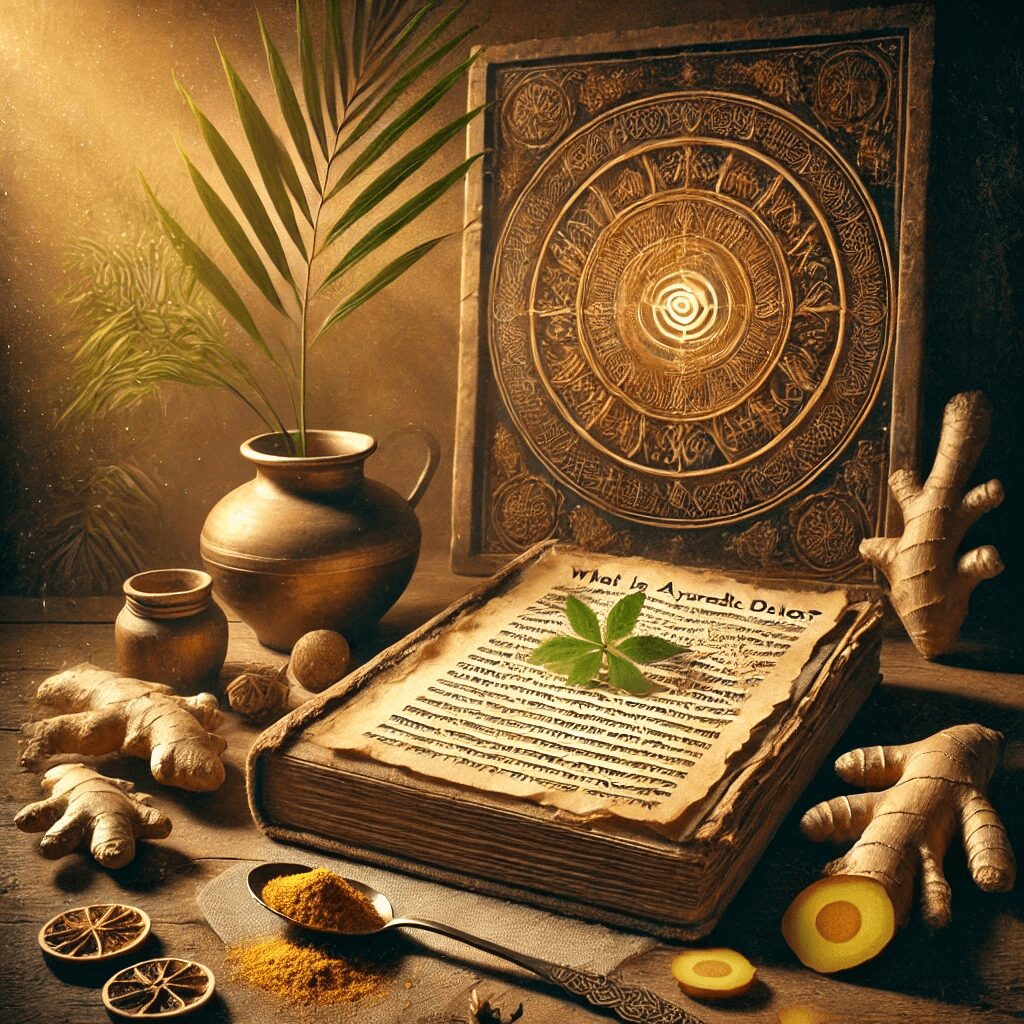
What is Ayurvedic Detox?
“Panchakarma,” or Ayurvedic detox, provides a natural, whole-body approach to detoxification. This detox period involves a carefully curated set of treatments intended to rid the body (and mind) of toxins, or “ama,” that build up over time through bad habits, food, routine, and more modern facets of life. In this way, the process is prescriptive, considering what is happening in an individual’s body and mind and the world immediately surrounding that person.
One of the main principles of Ayurveda lies in the concept of balance or a lack of excess. The practice teaches that balance leads to health through the three “doshas” (constitution types), which exist at differing levels in individuals. Each person has a mixture of Vata, Pitta, and Kapha. For some, an increase or decrease in one of those doshas may lead to significant problems, making detox helpful for maintaining (or regaining) balance. Accomplishing that can result in returning to a more former version of the self.
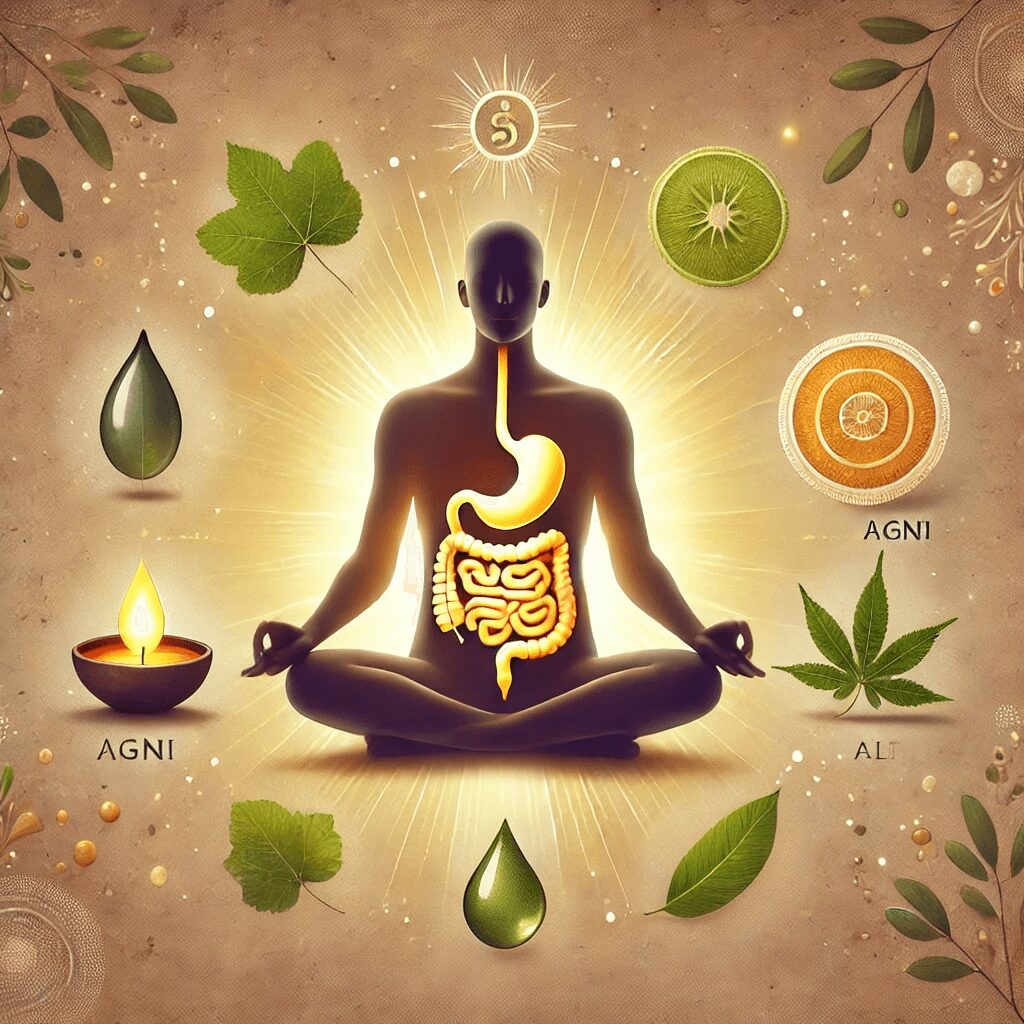
Why Cleansing is Essential for Health
Regular cleansing is essential for keeping your body and mind well-tuned. The cleansing process rids the body of toxins that will otherwise accumulate and lead to disease. Cleansing revives that spring in your step, makes the digestive process more efficient, and lightens and clears the complexion. As the body detoxes, the mind starts to clear, and the emotional body and spirit levitate above the heavy sludge. By cleansing regularly, you can maintain a certain level of vitality.
Ayurvedic cleansing, or Panchakarma, addresses the removal of toxins so precisely that the whole treatment is geared around removing toxic build-up from the body. It’s a whole-body cleanse comprising treatments. The idea is to balance the doshas and initiate the process so that toxins are eliminated in the best possible way. The treatment consists of practices infusing oil into the body via massage and heat treatments, such as herbal steam baths. Dietary procedures done before, during, and after treatment expedite the toxins’ or ama’s process on their way out.
Your body will thank you, and your mind will be glad.
Dealing with daily stressors will also become far less grueling. The onslaught of mental strain and intense emotional drama in our day-to-day lives heaps toxic pollutants into the body. With more mental clarity, a reduction in the level of emotional anxiety, and better tools to deal with stress in general, the average person would most likely put themselves in less toxic situations overall. Return to your body’s natural state with a stronger connection to your body and have a lasting keepsake to take away from the whole experience of PK: resilience.
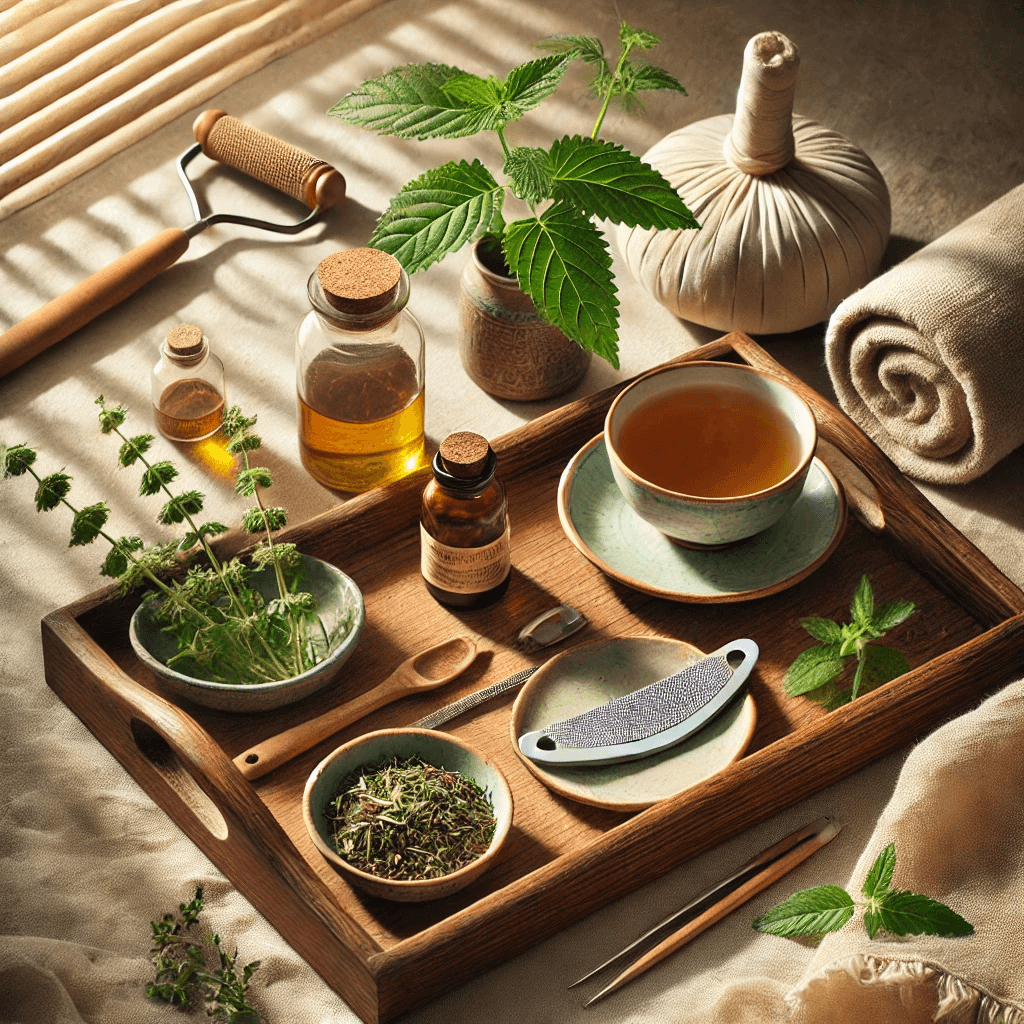
Exploring Natural Detox Techniques
Ayurveda, the old guard of Indian health-care science, tells us it’s healthy, maybe even essential, to take time for routine detoxification.
There are as many ways to detox as there are ways to get toxic, and Ayurveda recommends very doable, natural food and herb detox routines.
Food group number one on most detox diets, and Ayurveda agrees: whole, easy-to-digest, organic, non-GMO fruits, vegetables, and whole grains. Like the milieu of herbal remedies used in Ayurveda, the foods that make up their detox (and daily) diets include those that:
• detoxify the various systems of the body
• support overall physiological functioning, e.g., a long and quality life
• are dye-, additive-, preservative-, and lots-of-other-nasty-things-free (all things unlikely in nature)
If you’re unsure what a “whole food” is, you probably won’t find many in your usual grocery store. They are not, e.g., hybridized, genetically modified, sprayed with manufactured inorganic pesticides, or chock-full of artificial colors so that you’ll buy them.

The “herbs” I spoke of previously, in many cases, technically “fruits,” “seeds,” even “barks,” but the “herb” section just seemed like a good place to put them, including common “domestic” ones like turmeric. Prescribed in Ayurveda as a culinary “spice,” turmeric’s pharmacology goes far beyond the ability to “flavor or color foodstuffs or beverages,” the legal definition of a spice. The reigning queen of herbs in Ayurveda, turmeric is a hepatoprotective herb that is well-documented (and also just obvious) to protect the liver, the body’s primary detox organ (and a lot of other vata-business or normal physiological functioning), from the effects of those “xenobiotics,” so that the liver will (as much as possible) stay “normal” (or, “more normal, if that’s possible”), and keep up the good work! The herb’s only “downside:” Be careful when handling powdered spice. It will “stain” (color) most anything it encounters (and you will ingest whatever it is you are staining, in this case), including (or, maybe especially?) your clothes; otherwise, turmeric is, like most other Ayurvedic herbs, safe to use.]
Regarding fruits and safe-to-use, Triphala, or “three fruits,” a compound of three different species in the Rhamnaceae, or buckthorn family, is another very effective detox herb. Triphala (not trifle), also a very effective Rasayana (reference below), is the Ayurvedic equivalent of an over-the-counter drug: the “Milk of Magnesia” of the pharmacopeia, Ayurveda varsity players are virtually guaranteed to have some of.

Introducing a stress-busting yoga and/or meditation practice can help you normalize Vata. After all, stress is and causes (every disease, but if that does not concern you, not everyone will experience, wait for it, the premature graying of their hair (but it will be too much work for you to do, so most of you, don’t even try). Just kidding! If you are concerned about the possibility of PMG or gray hair, learn about the role of stress in Ayurveda disease theory, sometimes considered, e.g., PTSD, for which stress-relieving herbs like Ashwagandha can be used to treat or to prevent.
Okay, tent, big screen, time for bed! Many do not, for probably not a good reason. Also, essential (for Vata normalization), get to bed before the “BBC” 10 o’clock news! There are probably a couple of very good reasons (“vata reasons”-not that! Eh, maybe) why you don’t. Don’t forget to complete your morning routine before you start your day, i.e., professional, domestic, “other” (or, so you don’t “die”).
According to Ayurveda, the daily routine is like most things in Ayurveda. This complete science is somewhat complex but includes “systems,”
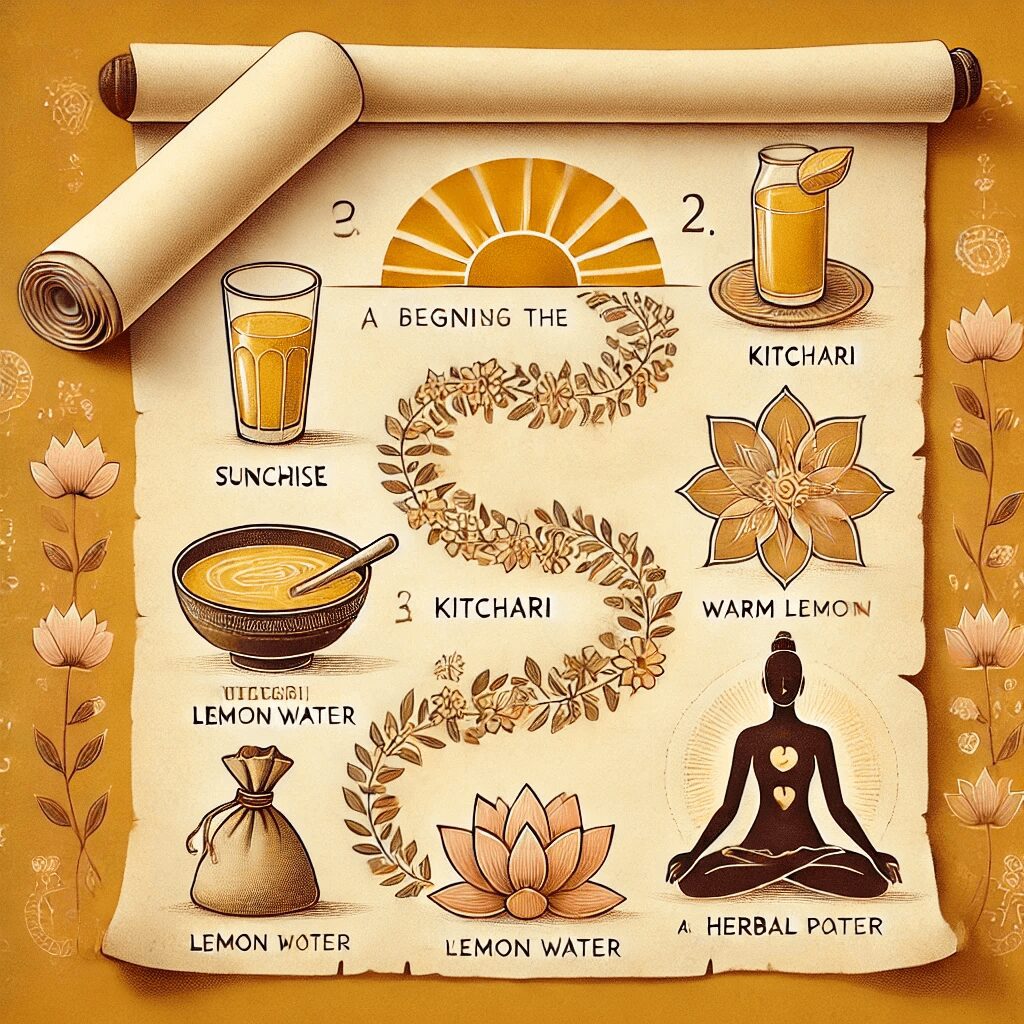
A Step-by-Step Guide to Ayurvedic Cleansing
Ayurvedic detox is basically about restoring balance to the body and mind and rejuvenating yourself.
Prep phase
At least about a week before you officially start your detox, start weaning yourself off of the processed foods and addictive things you know aren’t that great for you (I’m looking at you, caffeine, and you too, my friend alcohol).
Add whole, fresh, vibrant-in-color plant foods (think fruits, veggies, and whole grains) to your diet.
And rely more on exceptional “food and drink” recipes to get closer to your Ayurvedic goals.
Detox phase
It takes between three and seven days to return to balance if you eat a simple diet of kitchari, a stewed pot of rice mixed with beans (mung dal), and drink enough water.
Post-detox phase
Start eating lighter fruits and foods right after.
Take Ayurvedic herbs like Triphala. This can be ground with spices, seeds, or leaves such as fennel and anise and enjoyed as a tea.
Yes, you will eat regular food again! Complementary foods to avocado may include fruits, raw nuts, and seeds; warm grains; warm, light veggie soups; steamed veggies; and teas.
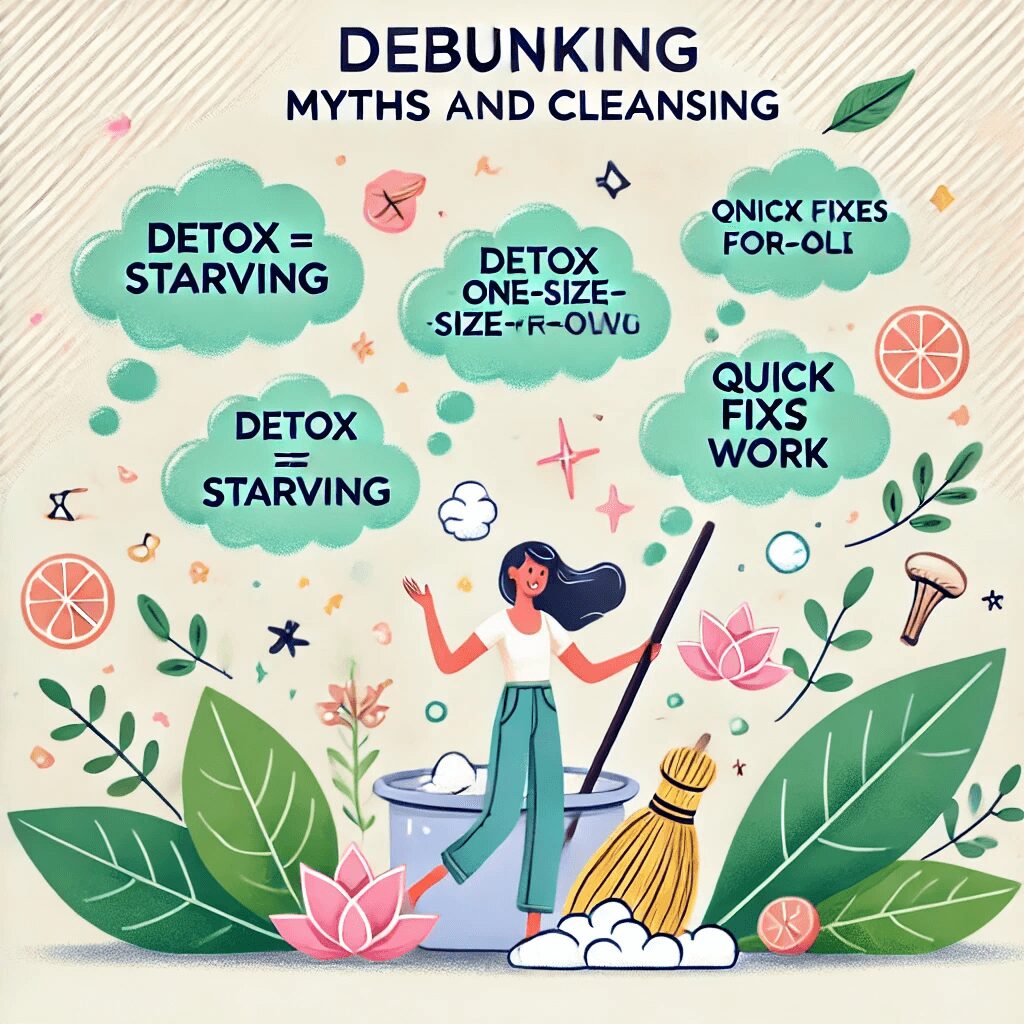
Debunking Myths Surrounding Detox and Cleansing
Detoxification is a prominent subject surrounded by many false facts, myths, and misinformation that lead many health-seeking individuals astray.
Detox diets do not remove toxins from your body; that’s what your liver and kidneys are for. Once your body identifies toxins, it swiftly deals with them and excretes them via urine, sweat, etc.
The word “detox” is often associated with problematic juice cleanses and restrictive “diets” in which you are likely not getting essential nutrients and overloading your body with sugar.
Ayurvedic detox differs vastly in that the aim is not weight loss; it guides individuals to understand their doshas (individual body constitutions) further and form educated opinions on what their unique body might specifically require more or less of.
It’s essential to note this method of “cleansing” should not come with restrictive tendencies; it is a practice to guide individuals toward a more well-balanced, straightforward, detoxified life.
Ayurvedic detox and cleansing practices provide a 360-degree view. Their origins are ancient Indian medicine focused on the whole person.
The detoxification methods (for instance, Panchakarma) specifically work on “ama,” a substance that arises from a poor diet, negative stress, an unhealthy lifestyle, and a polluted environment.
These toxins are waste material from undigested food. Clear skin? Yes, please. Boosted immunity? You bet. Sustainable weight loss? Hello, it’s yours to hold onto. And those are only a handful of the goals. Think increased energy, enhanced mental clarity, decreased joint pain, alleviated constipation, and reduced gas and acid reflux.
You’ll often do a home preparation phase before beginning an Ayurvedic detox involving dietary and lifestyle changes, given your “dosha” or body type (more on that in a little). But these things sound simple, and they are. They usually look like sipping on warm lemon water, having an apple or a pear for breakfast, and avoiding consuming raw, cold, dry, and light foods for Kapha types (for example). Should you explore a meeting to discuss dietary milestones with a holistic nutritionist or find this topic interesting, approach your time with her in a way that works best with you.

Many sages’ shamans blessed the Earth under this detox diet. But do so for your betterment, for your ease of fulfilling your needs (and wants), and for making our world a little bit better. Most, if not all, advanced nutrition coaching programs integrate and speak beautifully about Ayurvedic practices and will help you cater to what feels best within you: the Earth’s natural desire to recreate what and who is gentle and fulfilled.
To learn more, visit Ayurveda at Namaste Studios to book an Ayurveda session. Additionally, you can find more of our Ayurveda Blogs here.
For a Limited Time: Get your NEW MOON JOURNAL for a massive discount at Amazon here!
Bonus for blog readers: Watch how this Hybrid AI chatbot can save thousands of hours interacting with your clients. Click here for a FREE WEBINAR – It’s AMAZING!





